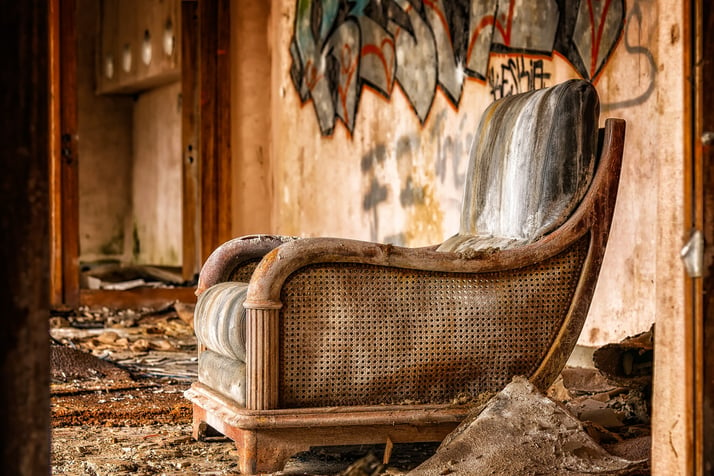
The average hotel goer can be forgiven for not caring where hotel furniture goes when it’s no longer wanted. But hoteliers, who have to decide what to do with the stuff, need to know their options.
There are other considerations, as well, that have nothing to do with disposal, such as:
-
What’s the best way to buy hotel furniture in the first place?
-
What should hotel furniture be made of to make it the best investment?
-
How can furniture be customized to serve its purpose better?
-
Do I need a shop drawing for my hotel furniture design?
-
What colors are best for hotel furniture?
But before we delve into and answer all of those questions, first things first…..
Where Does Old Hotel Furniture Go?
Looking for a simple answer, like, “It’s at the dump?” Sorry. Things are a bit more complicated. And for good reason. A landfill is the least attractive solution. It’s wasteful and, frankly, expensive.
Consider, for example, the sheer bulk of it. Fifty rooms worth of furniture is a lot. It has to be hauled, and that costs money. Dumping involves fees. It adds up. So what are the alternatives?
Believe it or not, used hotel furniture can find a home that saves hoteliers money. For example:
-
Liquidators. Simply put, a liquidator takes the furniture off the hotel’s hands for a low price, say $100 per room, or for free, and sells it to someone else at maybe 25 percent of the retail price of new furniture.
-
Donation to charity. Yes, just give it away. Save the labor, hauling and dumping fees, and get a tax deduction.
How Do Hotels Buy Furniture?
It takes a team to buy furniture, and usually involved the following people:
-
Hotel owner or design staff
-
Interior designers
-
Procurement specialist
-
Furniture manufacturer who functions as a true partner with the hotel
Each facet of the group has an individualized role that works in conjunction with the others to produce the perfect final, designed, product for the guest.
Hotel owners determine what guests will see and experience at the hotel. They are largely in charge of quality and budget. Designers bring owners’ vision to life, at least on paper. They know what the trends in furniture are and work with them creatively.
Procurement specialists can be independent companies or be employed by the hotel. They are responsible for taking the vision to its conclusion as furniture in the rooms.
Manufacturers, of course, make the furniture and deliver it. Hotel furniture manufacturers like Artone actually work with hotels from the design stage to the installation stage -- making the process even more streamlined.
For more information on the furniture procuring and manufacturing process, check out this complete timeline.
We can help you get the most from your investment in new hotel casegoods. Schedule a free consultation with one of our experts today!
What’s the Best Material for Making Hotel Furniture?
Short answer: it depends.
Leaving upholstery aside, the choices boil down to:
-
Stainless steel and other metals
-
Solid wood
-
Laminate on fiberboard
-
Wood veneer on fiberboard
Each choice has pros and cons, and the choice that is perfect largely depends on the overall design look that is being achieved, as well as durability needed, and budget considerations.
Here are some considerations associated with each of the above materials:
Metal. It’s strong and tough and can be great looking. If the goal is a modern look, metal might be the right option.
Solid wood. Think expensive. But it can be perfect for furniture that’s meant to be a centerpiece. It can also be quite heavy and hard to move.
Laminate. The new laminate designs do a great job of looking, and even feeling, like wood. Laminate materials also have vast color ranges -- making them a preferred material for many.
Wood veneer. Veneer is real wood, just very thinly sliced real wood. It can be used to create furniture that keeps the beauty of wood but weighs less, and is also easier to clean than upholstery or other materials.
In the end, the materials have to enhance the hotel’s intended look and feel, and that’s up to owners and designers.
How Can Hotel Furniture Be Customized?
The only limits on customizing furniture are design talent, money and the laws of physics. In other words, if it can stand up to use, it can be customized.
The real question is, “Why customize?” Here are a few reasons hotel owners and designers find attractive:
-
Helps achieve the desired look and feel for the hotel
-
Makes the best use of space
-
Sets the hotel apart from the competition
-
Gets guests talking about how cool the hotel is
-
Adds functionality that makes guests’ lives easier
Hotel furniture can be customized in almost any way you can imagine. From the perfect material, to the perfect size for a given space, to the perfect color range to match your design palette -- custom furniture can be the perfect option for any hotel owner.
Do I Need a Shop Drawing For My Hotel Furniture Design?
Hotel shop drawings are crucial when there are any alterations or construction changes that are needed in a hotel.
These preliminary and working drawings are created to show renovations, improvements, and plans for the hotel which may include things like balconies, stairways, windows, dressers, doors, ceilings, and even custom furniture.
The hotel shop drawings are very important, as they contain so much useful information needed for the alterations like plans, drawings, sketches, schedules, and more that are crucial for the project.
What’s more -- they’re free!
What Colors Are Best for Hotel Furniture?
Color trends are ever-changing, but if you’re renovating your hotel (or designing a new one!) this year -- it’s important to stay on top of this year’s trends and guest preferences.
Our design team recommends focusing on:
-
Movement toward warm colors, cool grays no longer take the spotlight
-
Rich pigments as so many paint companies are calling for in their 2019 predictions
-
Pairing with today’s neutrals like greige, cream, muted greens and blush tones
-
Classic material & color combinations such as terra-cotta
To read a complete guide to boutique hotel design trends we expect to be seeing, click here!
Need Some Furniture Advice?
Hotel furniture manufacturers are perhaps the best source of information about what goes into giving a hotel its unique personality. They’re familiar with everyone and everything that makes the process work.
Plus, a value engineering consultation is completely free -- so you can ask the questions about hotel furniture you’ve always been wondering and get the ball rolling on your next hotel furniture project completely risk free.

